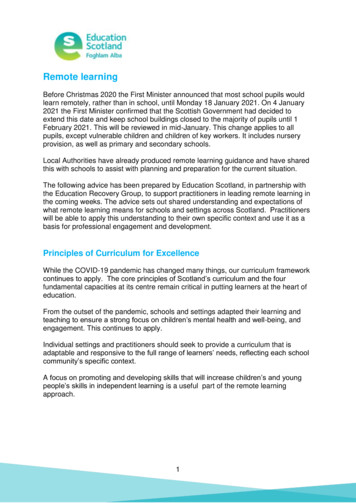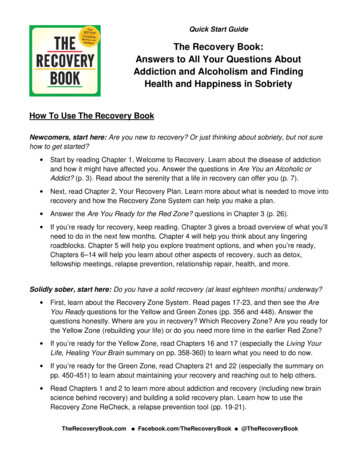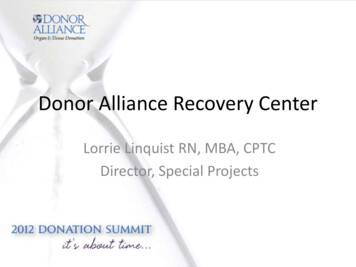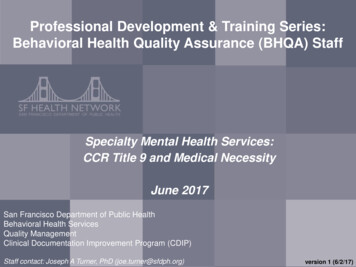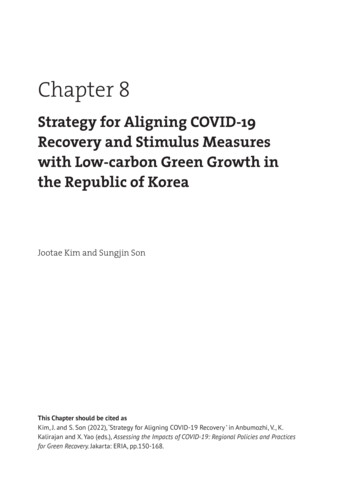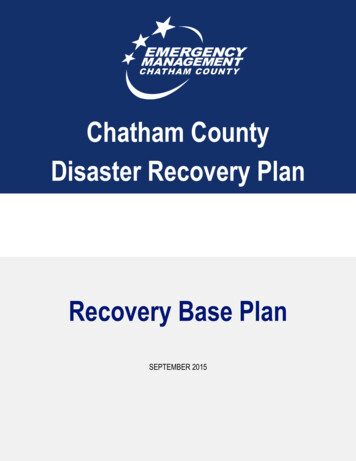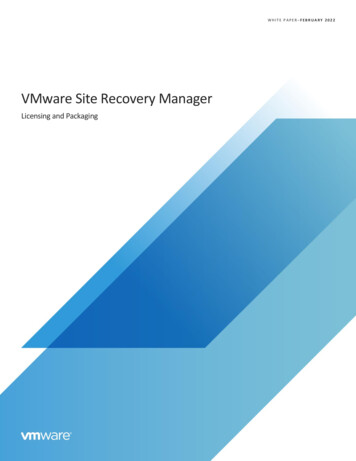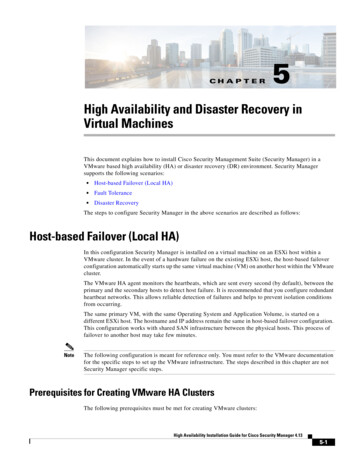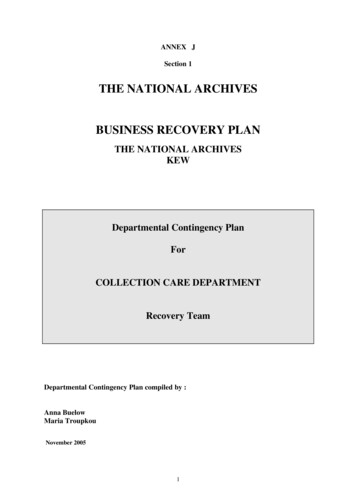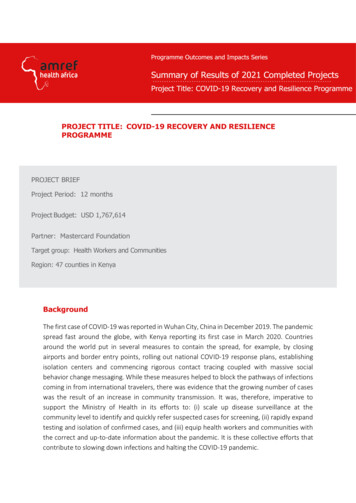
Transcription
PROJECT TITLE: COVID-19 RECOVERY AND RESILIENCEPROGRAMMEPROJECT BRIEFProject Period: 12 monthsProject Budget: USD 1,767,614Partner: Mastercard FoundationTarget group: Health Workers and CommunitiesRegion: 47 counties in KenyaBackgroundThe first case of COVID-19 was reported in Wuhan City, China in December 2019. The pandemicspread fast around the globe, with Kenya reporting its first case in March 2020. Countriesaround the world put in several measures to contain the spread, for example, by closingairports and border entry points, rolling out national COVID-19 response plans, establishingisolation centers and commencing rigorous contact tracing coupled with massive socialbehavior change messaging. While these measures helped to block the pathways of infectionscoming in from international travelers, there was evidence that the growing number of caseswas the result of an increase in community transmission. It was, therefore, imperative tosupport the Ministry of Health in its efforts to: (i) scale up disease surveillance at thecommunity level to identify and quickly refer suspected cases for screening, (ii) rapidly expandtesting and isolation of confirmed cases, and (iii) equip health workers and communities withthe correct and up-to-date information about the pandemic. It is these collective efforts thatcontribute to slowing down infections and halting the COVID-19 pandemic.
Mastercard Foundation funded Amref Health Africa to support COVID-19 control responseinterventions in Kenya. The COVID-19 Recovery and Resilient Programme was a 12-monthintervention that aimed at helping to flatten the COVID-19 curve in Kenya. The projectobjectives were:i.To rapidly expand community level surveillance, testing and isolation of confirmedcasesii.To equip health workers and communities with the correct and up-to-date informationabout the pandemicThe project was implemented in all the 47 counties in Kenya.ApproachIn order to achieve the above mentioned objectives, the project adopted the following fourstrategies:Strategy 1: Adopt digital solutions such as Leap to quickly train, refresh, frontline communityhealth volunteers (CHVs) based on MOH needs and priorities to respond to the COVID-19pandemic.This strategy aimed at equipping the CHVs with the knowledge to carry out diseasesurveillance, referral of suspected cases, contact tracing, upholding biosafety standards, andreceiving updates on correct measures to prevent and manage COVID-19 infections. Theproject leveraged Amref Health Africa’s existing technological infrastructure, relationships withthe MOH, and existing partnerships to rapidly roll out the training. This was in line with thegovernment’s policy of providing virtual training for health workers as a precaution againstCOVID-19 infections. The project developed training content that was delivered throughAmref’s innovative digital platform (Leap) to Community Health Volunteers (CHVs). A total offour topics, aligned to the MoH Curriculum and Guidelines for Training Community HealthVolunteers on Coronavirus Disease (COVID-19) were developed. The content writing processand subsequent translation was guided by Subject Matter Experts (SMEs) from the Ministry ofHealth and Amref Health Africa.Strategy 2: Harness the capacity of the Amref Central Laboratory (ACL) to provide additionalcapacity based on the Ministry of Health (MoH)’s need for support in handling the surge inCOVID-19 cases.Through this strategy, Amref provided the Ministry of Health with additional COVID-19 testingcapacity in response to the surge in COVID-19 cases. Key activities included capacity buildingof staff at the ACL on COVID-19 testing as well as procurement of equipment and reagents forCOVID-19 testing and personal protective equipment (PPEs) for use by the staff.Strategy 3: Health system strengthening to screen more COVID-19 cases according to WHOguidelines.
Activities under this strategy aimed at supporting the government of Kenya to expand thenumber of people tested for COVID-19. They included: equipping laboratories in the countrywith autoclaves, biosafety cabinets and biosafety cabinets motherboards to enhance theircapacity to provide additional COVID-19 testing; maintenance and certification of BiologicalSafety Cabinets (BSC); training of medical laboratory personnel to sensitise them on usingGeneXpert machines for COVID-19 testing.Strategy 4: Adopt the use of Jibu platform to train, refresh, frontline health care providers basedon MoH training needs and priorities to respond to COVID-19 pandemic.This strategy targeted health care providers in public, private and faith-based health facilities.They were trained using a digital platform on the following areas:i.Overview of COVID-19 infectionii.Infection prevention measures for COVID-19iii.Rapid Response Teams and Risk Communication.The project developed training content based on the MoH curriculum. In phase one, thetraining content was digitised into the three Modules and deployed to the health workersacross the country. As the pandemic evolved and feedback received, the MoH reviewed thematerials and requested to have them updated to enrich them by adding missing content suchas mental health and psycho-social first aid and Homebased isolation and care. Sevenregulatory boards/bodies (Nursing Council of Kenya, Clinical Officers Council, Association ofMedical Records Officers - Kenya, Pharmacy & Poisons Board, Kenya Nutritionists andDieticians Institute, Kenya Medical Practitioners & Dentist Council, Kenya Counseling andPsychologists Association) accredited the course and allocated it Continuing ProfessionalDevelopment (CPD) points. CPD points are prerequisites for renewal of health workers practicelicenses. This was a measure to motivate health care workers to take and complete the course.AccomplishmentsA total of 30,748 (97% of the 31,820 target) CHVs were enrolled on to the Leap and 33,256(100% of the 33,104 target) health care providers to the Jibu digital learning platformsrespectively. Through the training received, the HCPs were able to;(i)Constitute and strengthen Rapid Response and Risk Communication Teams (RRTs)(ii)Identify emerging needs, such as mental health issues in the COVID-19 response.The project harnessed the capacity of the Amref Central Laboratory (ACL) to provide additionaltesting capacity to the Ministry of Health’s (MoH) need for handling the surge in COVID-19cases. A total of 5,849 test were conducted at ACL. We collaborated with MoH to scale-uptesting beyond the conventional centralised real-time polymerase chain reaction (RT PCR)testing in a few well established facilities like Kenya Medical Research Institute (KEMRI). We
supported the government of Kenya to expand COVID-19 testing by introducing point of caretesting using GeneXpert platform. The project supported revamping of existing systems in theGeneXpert facilities by installing and commissioning of 33 autoclaves, certification of 12biosafety cabinets, procurement of two biosafety cabinets for Iten and Hola hospitals. The TurnAround Time (TAT) for results significantly reduced from several weeks to two hours.
Lessons LearnedLesson 1Lesson 2Lesson 3Lesson 4Lesson 5Lesson 6For effective CHV training, there is need to train adequate number of supervisors(CHEWS) first to cascade the training. The recommended ratio of CHV to Trainersis 10: 1, as opposed to the 30:1 in some counties, which made delivery of trainingand learner supervision a challenge.Competing activities from other projects within the counties that requiredlearners and supervisors’ attention affected timely course completion.There are emerging issues experienced during project implementation that needto be addressed through further collaboration. These include mental health andpsychosocial issues and COVID-19 Vaccination.Constant engagement and collaboration with MoH is a critical success factor inthe implementation of the programme.Building relations with key stakeholders in implementation of programmes yieldsbetter outcomes . We successfully partnered with MoH, Cepheid and Countiesto install autoclaves and train the 33 HFs to test for covid-19 using GeneXpertplatform.Blending online and face to face engagements with CHMTs and learnersimproved course uptake and completion.ConclusionThe COVID-19 Resilience and Recovery programme strenghthened health systems by buildingcapacities of MoH facilities to expand COVID-19 testing, training of health care providers byleveraging technology, provision of PPEs and laboratory equipment. This significantlycontributed to the country’s response to COVID-19 pandemic. Drawing from our experience,we identified potential areas for future collaboration including:i.Mental health and psychosocial careii.Institutionalisation of COVID-19 courses into pre-service and in-service trainingiii.Continue collaborating to support expansion of COVID-19 testing on GeneXpertplatform from the 14% coverage (33 of the 226 existing GeneXpert sites in Kenya) tothe remaining 193 sites that include private facilities.
1177/2158244015621777i)Training of CHVs in Kirinyaga County reported on local TV stationhttps://youtu.be/WQ8SLlK5siYii)Launch of project activities in Kirinyaga County was preceded by donation of 200 cartonsof hand sanitizers for distribution to community health workers reported by localnewspaper and posted on Kirinyaga County -health-volunteersiii)Launch of the Mastercard Foundation funded COVID-19 Resilience and RecoveryProgramme posted on the Amref )Training of healthcare professionals through Jibuhttps://jibu.africav)Other project activities posted on 98105344?s 08https://twitter.com/Amref Kenya/status/1332182251157790720?s 08Acknowledgement1. Mastercard Foundation2. Amref Health Africa (Institute of Capacity Development, Amref HealthInnovations, Amref Laboratory)Contact Person: Anthony Karanja Programme Manager, Kenyaantony.karanja@amref.org
Development (CPD) points. CPD points are prerequisites for renewal of health workers practice licenses. This was a measure to motivate health care workers to take and complete the course. Accomplishments A total of 30,748 (97% of the 31,820 target) CHVs were enrolled on to the Leap and 33,256
